Dear Reader, in this age of AI created content, please support with your goodwill someone who works harder to provide the human-made. Sign up at the top of the lefthand column or bottom of this page. You will receive my hand illustrated monthly newsletter RESTORE NATURE and access to the biodiversity garden design course as I write...and nothing else, I respect your time. I am also removing the advertizing as best I can as its become intrusive inappropriate and pays me nothing.
Shubhendu Sharma’s methods of afforestation
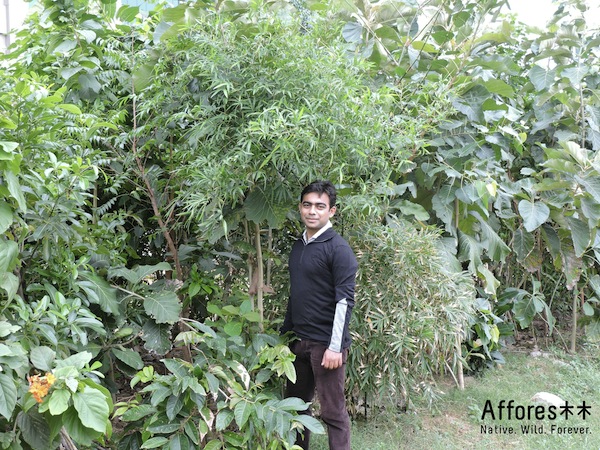 Shubhendu Sharma with his living green afforestation machines
Shubhendu Sharma with his living green afforestation machinesA passion for forests and afforestation can realize itself via many different routes and incorporate totally different skill sets. Shubhendu Sharma was a young engineer at Toyota in India. One day Akira Miyawaki (a Japanese botanist specializing in forest rehabilitation) visited their factory to do a forest planting project.
At that stage Miyawaki was very old and had become world famous for his forest planting, with many successful forests and many environmental accolades behind him. Sharma was intrigued that Miyawaki’s method established forests at ten times the speed of normal forestry practices, and was also able to establish a self sustaining forest ecosystem like that found in mature pioneer forest in a fraction of the time taken by natural recovery processes.
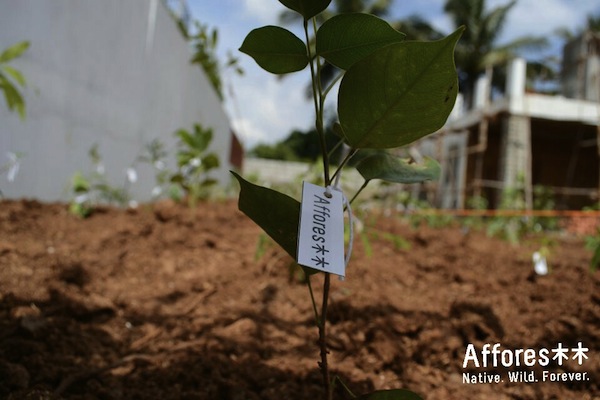 Saplings in a newly planted urban afforestation lot
Saplings in a newly planted urban afforestation lotThe young engineer’s life changed. He wanted to to plant such an efficiently growing forest himself and what better place to start than establishing an indigenous forest in his own back garden in Kashipur, Uttarakhand. The forest just fitted into his back garden. He planted a forest of 300 trees of 42 species on a 97 square metre plot, slightly less than the ideal 100 square metres for forest establishment.
The process must have been very instructive because one thing led to another and eventually the young engineer metamorphosed from a car production designer into a forest production designer. He started his own company, Afforestt, based on the logic, rationalization and optimization methods learned in the motor industry and on the ethos of the Miyawaki method. This would include concepts like potential natural vegetation, or the vegetation that would grow in an area without human interference, and the type of painstaking plant research applied by Miyawaki.
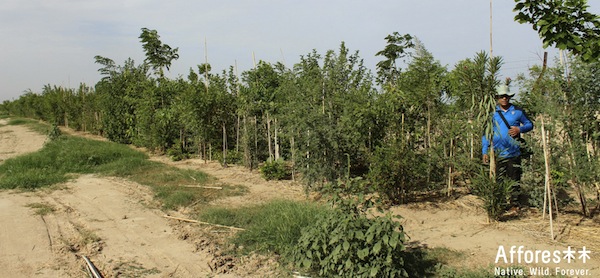 a new forest planted with mathematical precision
a new forest planted with mathematical precisionShubhendu Sharma's 6 step afforestation method
Sharma’s six step afforestation method is much like Miyawaki’s but he adds to it the power of software for calculating tree numbers, spacing and finding the best planting arrangement to make optimal use of vertical space :
SHARMA’S METHOD
1) First survey your site thoroughly and find out what elements the soil lacks.
2) Then survey the native vegetation thoroughly and determine what local plants would grow on such soil in the local microclimate. Research every species with reading and observation. Choose only native species which really thrive in that region, which you have seen thriving yourself. Do not base this on textbook data. Use the software to determine which plants will go in your four forest layers: canopy, tree, subtree and shrub, how they will be spaced and what numbers you need to raise.
3) Find a local biomass supply for restoring the soil. Amending the soil to a depth of one metre is recommended by Afforest.
4) Having used Sharma’s special software for determining placement and the quantities of various species, plant saplings with heights of up to 80 cm. Plant them densely, three to five per square metre.
5) Plant up a minimum of 100 metres square of tall forest.
6) Water and weed for the first two to three years, till the forest is self sustaining. Then leave it alone to allow its ecosystem to mature. Observe the forest and changing weather patterns and adjust species accordingly. About 92 per cent of the plants survive in Sharma’s plantings and he is striving to reduce tree losses further.
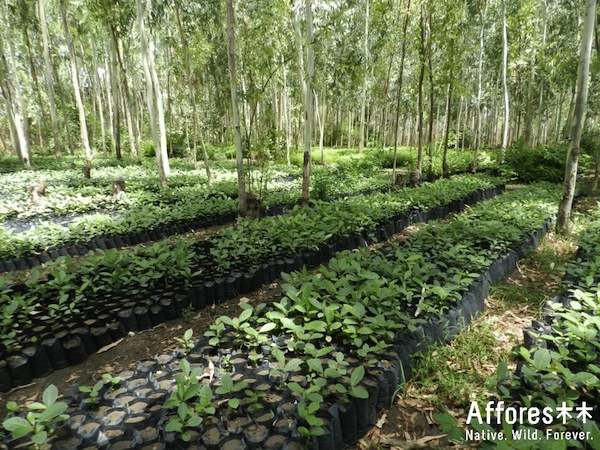 saplings waiting to become forests in awe inspiring numbers
saplings waiting to become forests in awe inspiring numbersHow could Sharma's afforestation methods be applied at the Cape ?
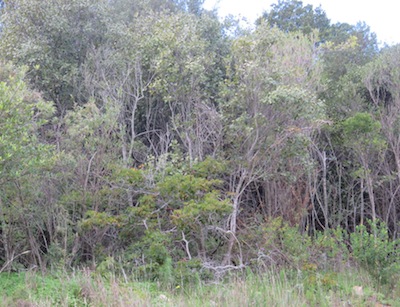 a dense recovering Afromontaine forest along the Kirstenbosch drive
a dense recovering Afromontaine forest along the Kirstenbosch driveAfromontaine forest circles ?
I calculate that the 100 square metre minimum for creating a forest ecosystem can be outlined by a 10 by 10m square or a circle with a 12 m diameter. At the Cape, Afromontaine forests normally grow in small bands in ravines and can thus establish on a small area. They could be planted in dense 12m forest circles which could be dotted around in larger areas with other vegetation, in parks, on roadsides, speedway islands, riverbanks, and large industrial lots and schoolyards, or they could be planted in 10 meter wide bands which could form ecological corridors. This is so exciting for the rehabilitation of the Afromontaine forest of the Cape, but there is more.
Tiny backyard forests ?
In the dry Fynbos biome, miniature forests with stunted bush sized trees forming climax canopy vegetation are much smaller than rainforest. To recreate these you would use Strandveld or Renosterveld bush clump species depending on your soil. The bush clumps of the Renosterveld have been called ‘Lilliputian forests’ by a visiting ecologist because though so small they contain the indicator species of much larger rain forests. If you establish a bush clump in your garden you have what is technically a forest ecosystem, on a few square metres, perhaps as little as 9 metres square.
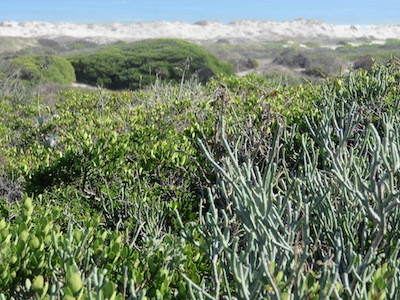 further miniaturization of afforestation possible ? Strandveld dune forest with 3m high hemispherical dark green bush clump canopy in mid ground and pioneer vegetation in foreground
further miniaturization of afforestation possible ? Strandveld dune forest with 3m high hemispherical dark green bush clump canopy in mid ground and pioneer vegetation in foregroundMiniaturized, fragile, low nutrient, stunted trees with shallow root mats for catching every drop
Like Gulliver, you would need to stoop to enter this forest, but into what a
magical space ! We do not have to have big gardens to grow micro-forest and
conserve forest habitat in the Cape. Small is beautiful when it comes to Cape
forests. They also prefer to be left undisturbed and their root mats are very
fragile, and die off if the soil gets compacted, so don’t peep into them too often, or build a boardwalk first before planting.
So we see that much less than 100 metres squared may be sufficient for a
miniature forest to establish a stable ecosystem. In a miniature Cape forest
the number of forest layers will likely be less. Note the Cape vegetation
thrives on low nutrient, leached soils and you may not have to do so much soil
amendment, to the same extent as in areas with generally nutrient rich soils.
Amending the soil to a metre depth may not be needed and may even be counter productive with our plants which can die from being overfed easily, and which may have smaller and shallower root systems. However, the aim of the soil enhancement would be to encourage rapid tree growth. At the Cape we will have to experiment to reach a balance between growth enhancement of some species and overfeeding of others, and perhaps settle for slower establishment rates that give that ‘bonsai’ effect so typical of our bush clumps. Rates of tree loss also may differ in our climate with its great seasonal extremes, and it may be difficult to achieve the superb survival rates that Sharma’s methodology does. However, this all seems do-able and can be scaled down enormously too to fit many contexts.
My dream is to start an afforestation project here. I am growing indigenous fruit trees now and looking for land to rehabilitate in the city, especially in areas where there is little green and people have no relief from harsh and impoverished urban environments. I am also looking for funding but I hope most of this can be accomplished with volunteers.
Since writing this article I have attended one of Shubhendu Sharma's afforestation webinars, and was able to speak face to face with him (what a privilege) and learn about the management of an afforestation project in greater detail. I am now applying for startup funding to get this project on the road and networking to find a space to build the first forest.
------
home page with information and tips on natural gardening
------
natural garden design and modeling on nature
------
video of Shebhundu Sharma's methods
------
Akira Miyawaki and his afforestation method
------
documentation on the Miyawaki method
Ask us ?
If you have any questions please let us know !
Restore Nature Newsletter
I've been writing for four years now and I would love to hear from you
Please let me know if you have any questions, comments or stories to share on gardening, permaculture, regenerative agriculture, food forests, natural gardening, do nothing gardening, observations about pests and diseases, foraging, dealing with and using weeds constructively, composting and going offgrid.
SEARCH
Order the Kindle E-book for the SPECIAL PRICE of only
Prices valid till 30.09.2023
Recent Articles
-
garden for life is a blog about saving the earth one garden at a time
Apr 18, 25 01:18 PM
The garden for life blog has short articles on gardening for biodiversity with native plants and regenerating soil for climate amelioration and nutritious food -
Cape Flats Sand Fynbos, Cape Town's most endangered native vegetation!
Apr 18, 25 10:36 AM
Cape Flats Sand Fynbos, a vegetation type found in the super diverse Cape Fynbos region is threatened by Cape Town's urban development and invasive alien plants -
Geography Research Task
Jan 31, 25 11:37 PM
To whom it may concern My name is Tanyaradzwa Madziwa and I am a matric student at Springfield Convent School. As part of our geography syllabus for this
"How to start a profitable worm business on a shoestring budget
Order a printed copy from "Amazon" at the SPECIAL PRICE of only
or a digital version from the "Kindle" store at the SPECIAL PRICE of only
Prices valid till 30.09.2023







